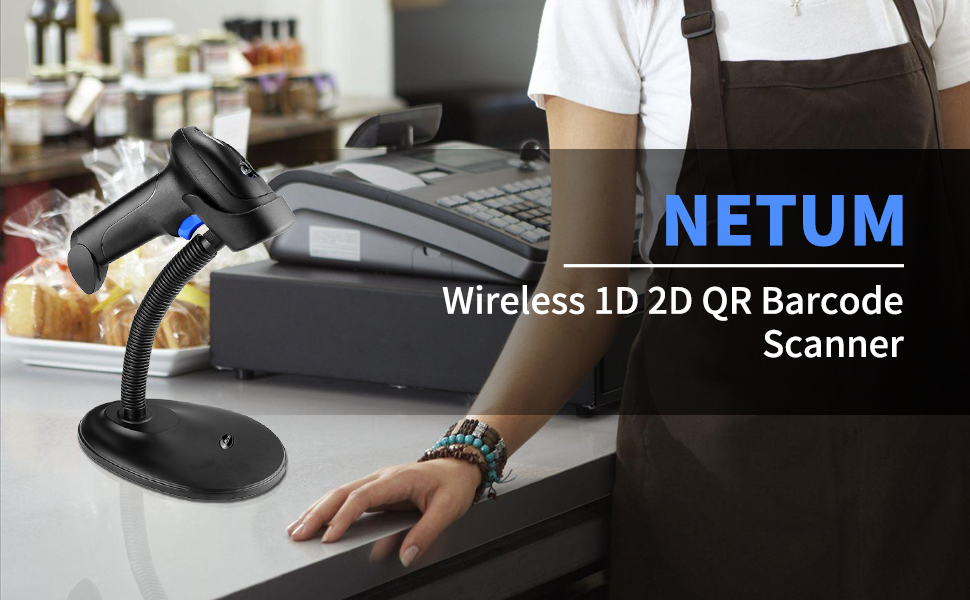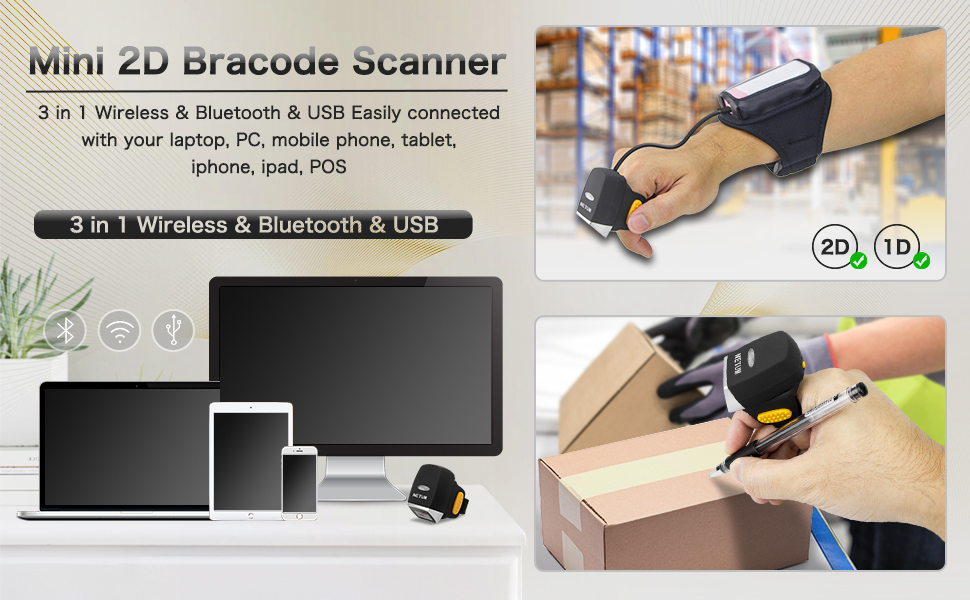Handheld barcode scanners are highly effective tools for industries like retail and warehousing, offering significant core advantages:

User-Friendly: Ergonomically designed with a gun-shaped or handle-style design, a lightweight 200-500g body, and non-slip material for comfortable grip. Easy-to-use button triggering makes it easy to learn.
Durable: Most offer IP54+ protection, withstand drops from 1.8 meters, and offer stable scanning in both bright and dim environments, making them suitable for complex scenarios.
Efficient Recognition: The intelligent decoding engine delivers a 99.9% first-scan success rate, enabling rapid recognition in 0.1 seconds, even with damaged and long-distance barcodes.
Flexible Compatibility: Supports USB and Bluetooth connectivity, compatibility with multiple systems and software like ERP and WMS, with real-time data synchronization.
Finger barcode scanners are a powerful tool for high-frequency mobile use, offering significant advantages:

Ultimate Portability: The Finger barcode scanners is compact, approximately 29 mm wide and weighs only 20 grams. Wearing it on your finger allows for complete hands-free operation.
Easy Operation: Scanning can be triggered by touching the ring's outer shell or pressing a micro-button, eliminating the need to lift your hand, making high-frequency scanning more efficient.
Application Compatibility: Suitable for dry indoor environments, such as e-commerce packaging and supermarket checkout, enabling two-handed collaboration.
Sufficient Battery Life: The ultra-low power design allows for 16 hours of continuous operation at a scan rate of every 3 seconds, meeting daily needs.
In retail, logistics, warehousing, and other scenarios, businesses often struggle with the choice between handheld and Finger barcode scanners barcode scanners. While neither is inherently superior, the key lies in whether they align with your core needs. Follow these three steps to quickly identify the right device.
Step 1: Initial Screening by "Work Environment"
The complexity of the environment and the degree of operational flexibility are the primary considerations for selection.
If your work environment involves industrial-grade requirements such as dust, humidity, and frequent drops, such as factory production line quality inspection, outdoor logistics loading and unloading, or heavy cargo inventory in large warehouses, a handheld barcode scanner is preferred. These devices are often certified IP54 or higher (for example, the Netum RD1202W can withstand drops from 1.8 meters), ensuring stable operation in harsh environments and avoiding downtime and losses caused by frequent equipment damage.
If your work environment is dry and requires frequent movement indoors, requiring both hands, such as packaging verification in e-commerce warehouses, rapid barcode scanning at supermarket checkout counters, or restocking pharmacies, a finger barcode scanner is more suitable. Its ring-shaped design allows workers to scan codes while simultaneously completing tasks such as picking, labeling, and bagging items. Finger barcode scanners are particularly suitable for high-intensity scenarios with an average daily scan volume exceeding 1,000.
Step 2: Focus on "Core Functional Requirements"
After clarifying the scenario, further narrow the scope based on performance requirements, focusing on the three key dimensions of "battery life," "compatibility," and "operational efficiency."
If you need to work continuously throughout the day and connect to multiple systems, such as large warehouses taking inventory throughout the day (requiring integration with a WMS system) or chain stores synchronizing multiple devices (requiring compatibility with Windows, Android, and iOS), handheld barcode scanners are a better choice. They generally offer a battery life of 8-12 hours and support multiple connection methods, including USB, Bluetooth, and Wi-Fi. They seamlessly integrate with enterprise management software and reduce data synchronization errors.
If you require extreme portability and fast operation, such as checkout during peak hours at convenience stores or sorting small items at express delivery outlets, finger-held barcode scanners are more advantageous. Taking the Netum R3L as an example, it can scan once every 3 seconds and operate continuously for 16 hours. A single scan eliminates the "raise-point-press" process; recognition is completed with a simple touch of a finger. According to industry data, efficiency in such scenarios can be improved by 20%-30%, effectively reducing customer wait times.
Step 3: Make a Final Decision Based on "Cost Budget and Return Cycle"
Balancing budget and long-term returns is a practical consideration for businesses when making a choice. This decision should be made based on two needs: "short-term savings" and "long-term efficiency gains."
If your budget is limited (under 500 yuan per device) or you only need basic scanning capabilities for a single scenario (such as checkout at a small grocery store or filing documents in an office), a standard handheld barcode scanner (wired models costing 100-500 yuan, wireless models 300-800 yuan) offers a more cost-effective solution. You don't have to pay a premium for extra features, and maintenance costs are low, making replacement costs manageable in the event of a failure. If you have a sufficient budget (800-1500 yuan per device) and are looking for long-term efficiency improvements and labor cost savings, such as in large e-commerce warehouses (where you need to reduce the number of packaging staff) or high-end supermarkets (where you need to improve the customer experience), finger scanners offer more significant long-term returns. For example, in retail stores, a single finger scanner can increase checkout efficiency by 30%, indirectly eliminating one or two temporary staff members during peak hours. The device's cost can be recovered in three to six months, reducing overall labor costs in the long term.
Summary: There's no "best," only "best fit."
The two types of devices aren't "substitutes" but rather "complementary scenarios." Handheld barcode scanners excel in durability, compatibility, and cost-effectiveness, making them suitable for industrial-grade, multi-system, and budget-constrained scenarios. Finger scanners, on the other hand, are portable, efficient, and labor-saving, making them suitable for high-traffic, two-handed applications that require long-term efficiency gains. When choosing a scanner, businesses can simply filter by "scenario → needs → budget" to accurately identify the "barcode scanning tool" that will truly improve business efficiency.

